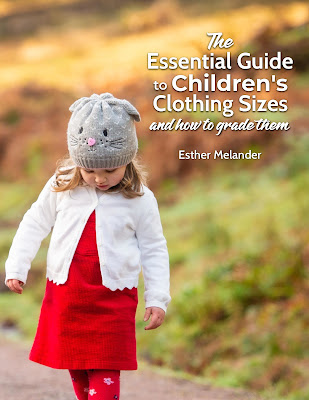There are a lot of children's body measurement charts floating around the Internet. But are they reliable? The answer to that question is difficult to determine. I have looked at some of the free charts out there and some are pretty good and others definitely have some anomalies. While I won't single out any particular chart, I would urge some caution on relying on whatever you can find freely on the Internet.
Some of the anomalies include inconsistent body measurements and differences between sizes. This may sound odd because you would expect that a size should measure what it measures. Having read a few measurement studies, the raw data that backs up body measurements are inconsistent between the sizes. But that raw data is difficult to work with, especially when it comes to grading. So statisticians and data analysts take the raw data and average it out. Then they take the average body measurements and adjust the numbers up or down small amounts to obtain numbers that are easy to work with as a convenience for pattern making and grading. This type of data manipulation does not result in fit anomalies as might be expected despite cries of vanity sizing and inaccuracies.
It's hard to say how these free charts available on the Internet came about. I suspect many of them are based off of cribbed data from various retailers. Some may be based on measuring some children. Some may be straight from official measurement studies. Regardless, caution is warranted.
You can use the free charts on the Internet, if you choose. It may be a place to start. It may also be a source of frustration if things aren't working quite right in your product development.
However, there are places to acquire body measurement charts. Some free, some not.
ASTM is an organization that develops standards, including body measurement standards. However, there standards are not free and contain restrictions on their use. This is the place for the most up-to-date measurement standards with sizing studies to back most of it up. Search for these standards on the Internet to find them.
D4910 - Size standard for infants, sizes preemie -24M
D6860 - Size standard for Boys, sizes 6-24, Husky
D6192 - Size standard for Girls, sizes 2-20, (Regular and Slim), plus sizes
D6829 - Size standard for Juniors, size 0-19
The U.S. government created a series of body measurement standards, which were in use into the 1980's. They were later withdrawn in favor of the ASTM standards. However, these charts are in the public domain and can still be found with some difficulty. In recent years the government has even pulled these from the Internet. They may still be found at government document repositories located within various libraries around the country or requested through standards.gov. I include complete copies of these standards in my book The Essential Guide to Children's Clothing Sizes. I created cleaned up versions of these standards that are easier to read in the appendix. I also include missing measurements from the original standard, which are the neck circumference, hand, and foot lengths and widths.
CS151-50 - Children
PS45-71 - Young Men
PS36-70 - Boys
PS54-72 - Girls
It is true that the withdrawn standards are a bit out of date. However, even the purchased, most up-to-date measurement charts from ASTM are based on this earlier standard. ASTM has added some sizes and refined some of the body measurements, but the similarities are still there. In other words, you can use the withdrawn standards as a good starting point in your product development and not be too far off. You will at least have a better foundation than using body measurement charts from unknown sources with questionable measurement data.
For this and more, see The Essential Guide to Children's Clothing Sizes.




